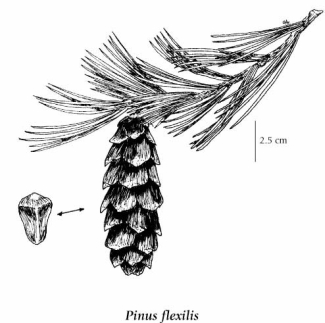limber pine
Pinaceae (Pine family)
Introduction to Vascular Plants
Introduction
This is an evergreen coniferous species of tree that is found in the Rocky Mountains in se BC.
|
Species Information
General:
Usually a contorted, dwarfed tree 4-15 (20) m tall but also shrubby and sprawling at timberline; bark grey when young, becoming thickened and brown to blackish; young twigs puberulent.
Leaves:
Needles in fives, 4-7 cm long; deep yellow green.
Cones:
Seed cones slender egg-shaped, light brown to greenish- brown, 8-25 cm long, deciduous; cone scales open at maturity; pollen cones red.
Illustration

If more than one illustration is available for a species (e.g., separate illustrations were provided for two subspecies) then links to the separate images will be provided below. Note that individual subspecies or varietal illustrations are not always available.
Illustration Source: The Illustrated Flora of British Columbia
USDA Species Characteristics
Flower Colour:
Green
Blooming Period:
Summer
Fruit/Seed characteristics:
Colour: Brown
Present from Summer to Fall
Source: The USDA
Ecology
The table below shows the species-specific information calculated from
original data (BEC database) provided by the BC Ministry of Forests and Range.
(Updated August, 2013)
| Site Information |
Value / Class |
||
|
Avg |
Min |
Max |
|
| Elevation
(metres) |
1659 | 871 | 2240 |
| Slope
Gradient (%) |
49 | 27 | 85 |
|
Aspect (degrees) |
186 | 34 | 340 |
| Soil
Moisture Regime (SMR) [0 - very xeric; 4 - mesic; 8 - hydric] |
2 | 0 | 4 |
| Modal
Nutrient Regime
Class |
C | ||
| #
of field plots species was recorded in: |
17 | ||
| Modal
BEC Zone Class |
ESSF | ||
|
All BEC Zones (# of stations/zone) species was recorded in |
ESSF(10), ICH(1), IDF(4), MS(1) | ||
|
Source:
Klinkenberg 2013
|
|||
Habitat and Range
Mesic to dry slopes in the subalpine zone; infrequent in the Rocky Mountains of SE BC; E to SW AB and S to S CA, AZ, NM, and NE.Status Information
| Origin Status | Provincial Status | BC List (Red Blue List) | COSEWIC |
|---|---|---|---|
| Native | S2S3 | Blue | E (Nov 2014) |
BC Ministry of Environment: BC Species and Ecosystems Explorer.
Taxonomic Keys
1. Needles 2 or 3 in a bundle.
2. Needles in bundles of 3, 12-20 cm long..........................Pinus ponderosa
3. Cones spreading at right angles or reflexed, the scales armed with prickles...............................Pinus controta (2 varieties)
1. Needles usually 5 in a bundle.
4. Cones long-stalked, 15-25 cm long, 6-9 cm thick at maturity; cone scales thin and flexible; seeds prominently winged..........................Pinus monticola
5. Cones 8-25 cm long, opening at maturity; scales light brown, thinned somewhat toward the tip...............................Pinus flexilis Source: The Illustrated Flora of British Columbia |
Taxonomic Notes
Identification: Limber Pine is a member of the white pine group, Pinus subgenus Strobus, and like all members of that group, the leaves ('needles') are in fascicles (bundles) of five, with a deciduous sheath. This distinguishes it from the Lodgepole Pine, with two needles per fascicle, and the bristlecone pines, which share five needles per fascicle but have a semi-persistent sheath. Distinguishing Limber Pine from the related Whitebark Pine, also a white pine, is very much more difficult, and can only easily be done by the cones. In Limber Pine, the cones are 6-12 cm long where the species overlap, green when immature, and open to release the seeds; the scales are not fragile. In Whitebark Pine, the cones are 4-7 cm long, dark purple when immature, and do not open on drying, but are fragile and are pulled apart by birds (see below) to release the seeds. A useful clue resulting is that Whitebark Pines almost never have intact old cones lying under them, whereas Limber Pines usually do. In the absence of cones, Limber Pine can also be hard to tell from Western White Pine where they occur together in the northern Rockies and the Sierra Nevada east slope. The most useful clue here is that Limber Pine needles are entire (smooth when rubbed gently in both directions), whereas Western White Pine needles are finely serrated (feeling rough when rubbed gently from tip to base). Limber Pine needles are also usually shorter, 4-7 cm long, to Western White Pine's 5-10 cm (though note the overlap).
Note source: Wikipedia (http://en.wikipedia.org/wiki/Limber_Pine), accessed July 17, 2009 |